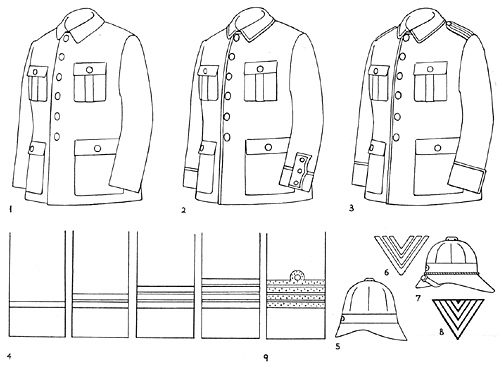Europeans (White, or German, officers and NCO's) of the Wissmann Unit were issued with a white uniform for garrison duty in station. This consisted of a white jacket with yellow metal buttons (1) and white trousers. At first this was also worn in the field on expedition, however, a separate uniform came to be prescribed for field duty. This followed the same pattern, in khaki for officers and gray for NCOs. A "hunting dress" was also tried, but after a brief trial all Europeans wore khaki expedition dress in the field. This consisted of a khaki jacket with yellow metal buttons (1) and khaki trousers, but it appears that variations in style, and color existed.
Headwear consisted of white sun helmet with black-white-red national cockade on the front (5). These were worn as is to begin with, but in 1890 khaki covers were issued for expedition dress. The NCOs frequently wore a round cork hat with a wide brim and low crown, white, looking like a soup plate. For garrison duty there was a white peaked cap with black peak and chin strap.
For garrison duty with the white uniform they wore white canvas shoes. For field duty there was a choice of natural leather boots or leggings according to Kneuttinger in Zinnifigur. Haupt writes that up to 1890, officers and NCos wore cloth leggings with the khaki uniform. After that they wore puttees.
To begin with, the grade chevrons worn by NCOs were of black-silver-red braid (6). Worn on the left forearm, one chevron denoted the rank of Unteroffizer, two the rank of Sergeant, and three the rank of Feldwebel. An officers rank was denoted by rows of the same braid around the sleeves (4), one - Proviantmeister (Commissary), Deckoffizer (Warrant Officer); two - Leutnant (Lieutenant), Arzt (Medical Officer); three - Chef (Chief), Chef-Arzt (Chief Medical Officer); four - Kommandant (Wissmann). This braid was not color-fast however, and was soon replaced in 1889 by yellow on both the khaki and white uniforms. In the case of officers, the top row of braid now received a "ring" (9) in emulation of the British. From mid-1889 on officers also wore shoulder straps of black, white, and red mix. From 1890 the shoulder straps corresponded to the rank held in the Wissmann Unit.

Uniforms of European Troops in East Africa
Back to The Heliograph's German Colonial Military Uniforms: Africa Table of Contents
Back to The Heliograph List of Issues
Back to Master Magazine List
© Copyright 2003 by Richard Brooks.
This article appears in MagWeb.com (Magazine Web) on the Internet World Wide Web.
Other articles from military history and related magazines are available at http://www.magweb.com